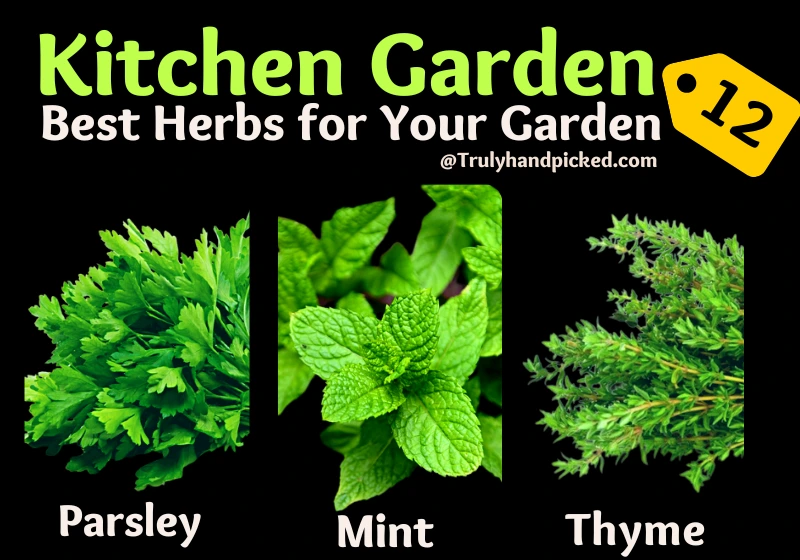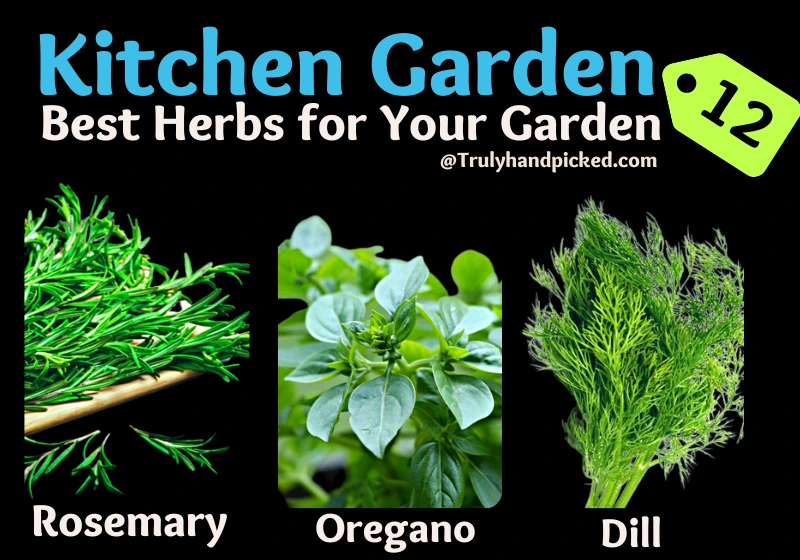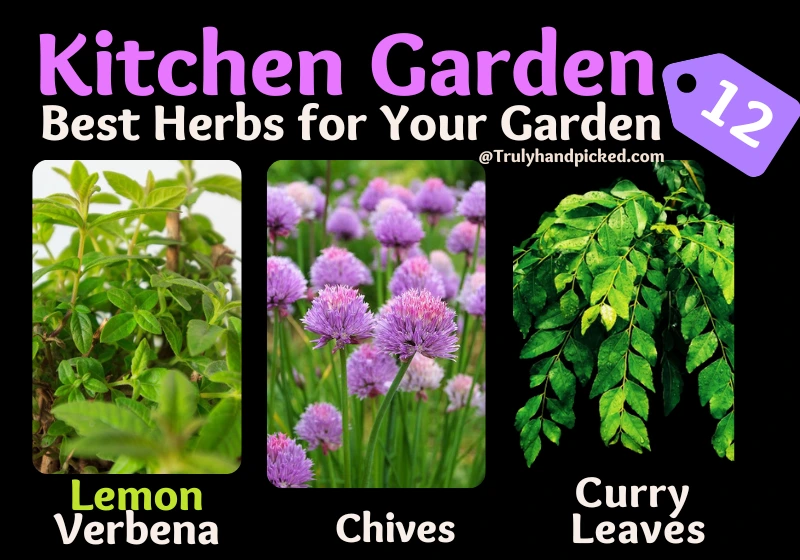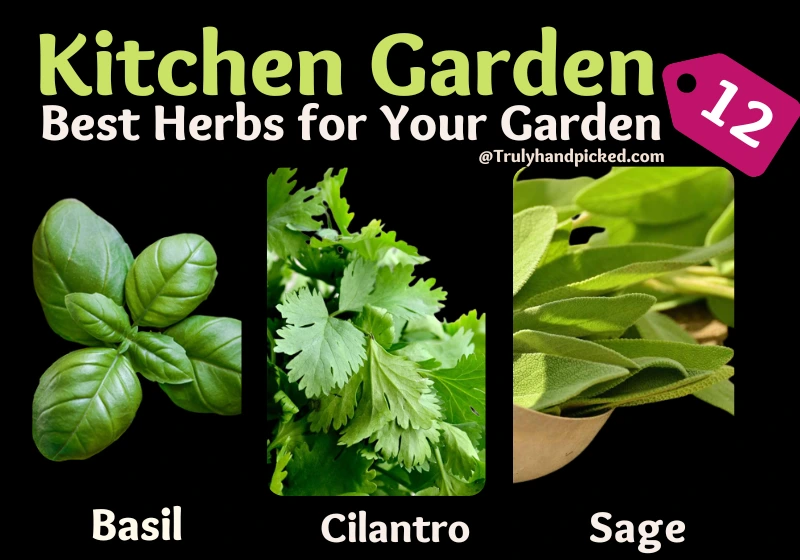Growing herbs in your own house are beneficial in plenty of ways. You can save money by buying such crucial herbs from the market.
It fulfills our desire of gardening in the most labor-free way. Above all, you don’t need any additional gardening area to start herb gardening in your home.
Only a small area to put a planter or hang a basket or a tiny space on your terrace is enough to begin and continue herb gardening optimally. So, here we drop some best herb ideas in this regard, which are easy to cultivate with minimal caring methods-

12 Best Herbs For Your Aromatic Kitchen Garden
Parsley:
About The Plant:
Parsley is a great herb that can add an extra flavor to your food when applied in the right way. It can improve our digestion power deeply, while used in our food. This plant can grow up to 1-3 feet long with a wide 8-24 inches spread with adequate care.
Avoid planting parsley along with garlic, onion, and shallots-like plants as it may slow down your parsley’s growth.
Growing Tips:
- Sow your parsley plant in a rich and moist soil that could drain well
- Place it under full sun and direct sunlight
- Feed-in every 2-3 weeks with half-strength of liquid fertilizer
- And water twice every week

Mint:
About The Plant:
Mint herb is one of the most beneficial plants that enhance our health in various ways. From improving our eyesight to boosting our digestion system, mint can augment our health effectively. It can grow up to 1-2 feet tall with a spread of 1-4 feet in the best thriving condition.
Apart from these benefits mints are good to repel harmful pests and attracting beneficial insects to your garden. Pests include mosquitoes and mice too.
Quick Care Tips:
- Plant this herb in a moist, rich, well-draining soil
- Put it under the sun with partial shade
- Water once per week with 1-inch deep watering
- And feed your plant once a month with composted manure
Also read Fragrant plants to repel pests.
Thyme:
About The Plant:
`Thyme is a great herb option to cultivate in your home due to its uncountable medicinal benefits. It’s one more quality is that thyme is a good companion plant for many other herbs. It can grow up to 6 to 12 inches long with a spread of 15 to 18 inches with proper care.
While doing harvest go for soft stems and avoid woody stems. As you thyme can spring back and grow bushy and strong from these woody stems. Yes, thyme will grow back better after cutting.
Plant care tips:
- Use a well-drained rich potting mix with an acidic pH level
- Water your plant once a week with the right amount
- Place the plant under the full sun for bright and direct sunlight
- And feed it once or twice a year, during the summer or springtime
About The Plant:
This perennial shrub is a wonderful and beneficial herb option to grow in your house. You can either use its dry form or apply its essential oil for therapeutic purposes. It can grow up to 1 to 8 feet long with a width of 2 to 4 feet spread, depending on its selected species.
Rosemary is a Mediterranean herb that can handle frost quite well and loves sunny spots. Avoid planting rosemary near mint, which for the cabbage family (cauliflower, cabbage, broccoli, and Brussel sprouts) it is beneficial to keep pests away.
Growing Tips:
- Plant it in sandy and well-drained type soil
- Place it under full sun and direct light with a high humidity level
- Water the herb once every week with 1-inch deep watering
- And feed any organic liquid fertilizer once a week

Oregano:
About The Plant:
Oregano is a perennial herb that contains plenty of nutrition and minerals in its tiny torso. It is most appreciated for the richness of its antibacterial agents and antioxidant properties. A healthy oregano plant can grow up to 1-3 feet long with a spread of 2-4 feet in width.
Oregano is a good companion plant for cabbage family plants and plant-like eggplant, peppers, and similar plants which fight with aphids. As oregano can help your plants to keep the aphids away from the spot.
Oregano is hardy and drought tolerant, which can spring back from its roots every year. And oregano plants can last 5-6 years, while slowly it becomes leggy with stems and lesser leaves.
Quick Care Tips:
- Plant this herb in a mediumly moist well-drained potting mix
- Water it sparingly likes once every 7-10 days
- Place it under full sun to the sun with partial shade
- And feed only with weeds once a month, as this is a low feeder herb
Dill:
About The Plant:
This is an excellent flavoring herb that can enhance the taste of your food outstandingly. At the same time, the usage of dill in your food even enhances your health organically in several ways. This plant could grow up to 3-8 feet and 2-3 feet wide.
Dill can happily grow in well-draining deep containers along with a spot receiving plenty of sunlight.
Dill is not a perennial that dies as a plant every year, it can re-seed itself from flowers landing on soil, germinate and come back again every year.
Growing Tips:
- It prefers loamy, moist, and rich soil with good drainage quality
- Place this herb under full sun and in a highly humid climate
- Water your plant once a week and let the soil dry between watering
- And feed your plant with an organic fertilizer like compost, once every 2-3 weeks

Curry Leaf Plant:
About The Plant:
This south Indian herb is highly noted for its signature flavor and essence. Several people use this herb in their cooking to get instant, rich, and rubout flavor. A healthy curry leaf plant aka sweet neem could grow up to 6-15 feet tall with a wide spread of 4-12 feet width.
Curry plant vs curry leaves: Don’t get confused by curry plant vs curry leaves, as the curry plant is greenish grey in color and used in flavoring cheese spreads, tea, salads, and mayonnaise and produces yellowish flowers at the end.
While curry leaves discussed here are aromatic leaves used in Asian cooking for their flavor and health benefits.
Growing Tips:
- Sow this plant in fully fertile and well-drained soil with an acidic pH level
- Place under the full sun for direct sunlight
- Water it daily for the first 3 months and then, twice a week
- Feed your plant with a nitrogen-rich fertilizer every 2 months
Lemon Verbena:
About The Plant:
Lemon verbena is a highly beneficial herb to grow in your garden. It can help you with digestive issues, sleeping trouble, skin problems, and even respiratory infection expertly. A healthy plant could grow up to 4-10 feet tall with a minimal 12 inches spread.
Young tender leaves of lemon verbena are used in salads, soups, salsa, marinades, and pesto. Also, note lemon verbena and lemon balm are not the same as lemon balm belongs to the mint family.
Growing Tips:
- Plant your herb in a moist, fertile, and well-drained soil with slightly acidic quality
- Let it grow under full sunlight
- Water the top 2-inches of the soil every 2-3 weeks
- And feed your plant with compost or manure tea once a week
Chives:
About The Plant:
Chives are an individual herb that has a combined taste of garlic and onion green. It can enhance the taste of the food in plenty of ways. Chives have several beneficial nutrients like vitamin C, vitamin B6, iron, magnesium, etc. It can grow up to 12 inches tall and with 12 inches spread when grown properly.
Chive companion plants: If you are planting in the same container avoid planting oregano, rosemary, lavender, and thyme together with chives. As the watering needs of chives are different from the above ones, it is a good companion plant for basil, cilantro, and parsley.
Growing Tips:
- Sow your chive in loamy or sandy, slightly acidic soil with well-drained quality
- Water it once every 7-10 days and apply to mulch
- Place it under the full sun for bright and direct light
- And feed it with any liquid high-phosphorus fertilizer every 4-6 weeks
Related read – Best plants for your hydroponic garden.

Basil:
About The Plant:
Basil is a great herb to have in your house for many purposes. Regular consumption of basil could help in lowering blood pressure, improving digestion, beautifying skin cells, fighting mental issues, controlling diabetes, etc. A healthy basil plant could grow up to 1 to 3 feet tall with a nice spread of 2-3 feet width.
Companion plants for basil: Just like chives basil doesn’t go well with dry herbs like sage, rosemary, or thyme also avoid planting with cucumber and fennel which can raise the competition for water and nourishment.
Basils are good companion herbs for tomatoes, yes in the garden and in your plate. Also, you can choose moist soil-loving herbs like chives, cilantro, and parsley and good with asparagus, peppers, and root vegetables too.
Avoid mid-scorching sun while morning bright light is preferable for basil.
Growing Tips:
- Sow it in a moist, rich, and well-drained soil
- Let it thrive under full morning sun with 6-8 hours of direct sunlight
- Water it 1-inch deep every week
- And feed it with any good organic fertilizer every 4-6 weeks
Coriander/Cilantro:
About The Plant:
Coriander, also known as cilantro, is a type of parsley from China. This herb contains heavy flavoring quality with several health benefits. Coriander is a great source of vitamins A, C, and K with some good minerals. A healthy coriander plant could grow up to 12 to 22 inches long with an equal amount of spread.
Cilantro Companion Plants: Cilantro loves well-draining moist and rich soil, so goes good with basil and similar plants, yet is not good for tomatoes and peppers. Also avoid planting with dry herbs, while a private space for cilantro is recommended for a better harvest.
Can come back every year? Harvesting above the mid stem can help cilantro grow back and give more cycles of harvest from the same plant. While it can also reseed itself if is allowed to flower and seed itself. Cilantros can are good for salads and can also be eaten fresh and raw.
Growing Tips:
- Plant this herb in a perlite and sand mix potting soil with a slightly acidic pH
- Water your plant with the aim of 1-inch per week
- Place your plant under the sun with partial shade for bright but indirect light
- And feed your growing plant with an organic liquid fertilizer like compost tea, once a month
Sage:
About The Plant:
Salvia Officinalis, commonly known as sage is a great herb to grow in your garden. It is mostly used to treat plenty of chronic health issues organically. Ingestion of sage or its extract could help in controlling mental issues, cholesterol, and menopause issues efficiently. A sage plant could grow up to 1-3 feet tall with a width of 2-3 feet spread.
Companion plants for sage: Sage doesn’t go well with moist soil-loving herbs, yet having sage near cabbage family plants can be beneficial to battle cabbage worms and beetles. Also sage is okay and good to plant with oregano, lavender, thyme, and rosemary.
Growing Tips:
- Sow your plant in rich, well-drained soil with an acidic pH level
- Water your plant twice a week with a mild amount of water
- Let it thrive under full sun to the sun with partial shade
- And feed it with any high-nitrogen fertilizer once a month.